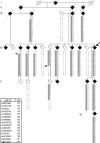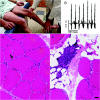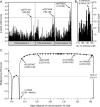Dominant spinal muscular atrophy with lower extremity predominance: linkage to 14q32
- PMID: 20697106
- PMCID: PMC2918478
- DOI: 10.1212/WNL.0b013e3181ec800c
Dominant spinal muscular atrophy with lower extremity predominance: linkage to 14q32
Abstract
Objective: Spinal muscular atrophies (SMAs) are hereditary disorders characterized by weakness from degeneration of spinal motor neurons. Although most SMA cases with proximal weakness are recessively inherited, rare families with dominant inheritance have been reported. We aimed to clinically, pathologically, and genetically characterize a large North American family with an autosomal dominant proximal SMA.
Methods: Affected family members underwent clinical and electrophysiologic evaluation. Twenty family members were genotyped on high-density genome-wide SNP arrays and linkage analysis was performed.
Results: Ten affected individuals (ages 7-58 years) showed prominent quadriceps atrophy, moderate to severe weakness of quadriceps and hip abductors, and milder degrees of weakness in other leg muscles. Upper extremity strength and sensation was normal. Leg weakness was evident from early childhood and was static or very slowly progressive. Electrophysiology and muscle biopsies were consistent with chronic denervation. SNP-based linkage analysis showed a maximum 2-point lod score of 5.10 (theta = 0.00) at rs17679127 on 14q32. A disease-associated haplotype spanning from 114 cM to the 14q telomere was identified. A single recombination narrowed the minimal genomic interval to Chr14: 100,220,765-106,368,585. No segregating copy number variations were found within the disease interval.
Conclusions: We describe a family with an early onset, autosomal dominant, proximal SMA with a distinctive phenotype: symptoms are limited to the legs and there is notable selectivity for the quadriceps. We demonstrate linkage to a 6.1-Mb interval on 14q32 and propose calling this disorder spinal muscular atrophy-lower extremity, dominant.
Figures



Similar articles
-
Autosomal dominant spinal muscular atrophy with lower extremity predominance: A recognizable phenotype of BICD2 mutations.Muscle Nerve. 2016 Sep;54(3):496-500. doi: 10.1002/mus.25114. Epub 2016 Jul 9. Muscle Nerve. 2016. PMID: 26998597
-
Novel BICD2 mutation in a Japanese family with autosomal dominant lower extremity-predominant spinal muscular atrophy-2.Brain Dev. 2018 Apr;40(4):343-347. doi: 10.1016/j.braindev.2017.12.001. Epub 2017 Dec 19. Brain Dev. 2018. PMID: 29273277
-
Phenotypic and molecular insights into spinal muscular atrophy due to mutations in BICD2.Brain. 2015 Feb;138(Pt 2):293-310. doi: 10.1093/brain/awu356. Epub 2014 Dec 14. Brain. 2015. PMID: 25497877 Free PMC article.
-
Congenital autosomal dominant distal spinal muscular atrophy.Neuromuscul Disord. 1998 Aug;8(6):405-8. doi: 10.1016/s0960-8966(98)00042-x. Neuromuscul Disord. 1998. PMID: 9713859 Review.
-
Autosomal dominant congenital spinal muscular atrophy--a possible developmental deficiency of motor neurones?Neuromuscul Disord. 2008 Jul;18(7):530-5. doi: 10.1016/j.nmd.2008.04.016. Epub 2008 Jun 24. Neuromuscul Disord. 2008. PMID: 18579380 Review.
Cited by
-
Low dietary protein content alleviates motor symptoms in mice with mutant dynactin/dynein-mediated neurodegeneration.Hum Mol Genet. 2015 Apr 15;24(8):2228-40. doi: 10.1093/hmg/ddu741. Epub 2014 Dec 30. Hum Mol Genet. 2015. PMID: 25552654 Free PMC article.
-
Neurochondrin interacts with the SMN protein suggesting a novel mechanism for spinal muscular atrophy pathology.J Cell Sci. 2018 Apr 17;131(8):jcs211482. doi: 10.1242/jcs.211482. J Cell Sci. 2018. PMID: 29507115 Free PMC article.
-
Molecular defects in the motor adaptor BICD2 cause proximal spinal muscular atrophy with autosomal-dominant inheritance.Am J Hum Genet. 2013 Jun 6;92(6):955-64. doi: 10.1016/j.ajhg.2013.04.013. Epub 2013 May 9. Am J Hum Genet. 2013. PMID: 23664119 Free PMC article.
-
Novel mutations expand the clinical spectrum of DYNC1H1-associated spinal muscular atrophy.Neurology. 2015 Feb 17;84(7):668-79. doi: 10.1212/WNL.0000000000001269. Epub 2015 Jan 21. Neurology. 2015. PMID: 25609763 Free PMC article.
-
Novel dynein DYNC1H1 neck and motor domain mutations link distal spinal muscular atrophy and abnormal cortical development.Hum Mutat. 2014 Mar;35(3):298-302. doi: 10.1002/humu.22491. Epub 2014 Jan 3. Hum Mutat. 2014. PMID: 24307404 Free PMC article.
References
-
- Pestronk A. Hereditary motor syndromes. Available at: http://neuromuscular.wustl.edu. Accessed November 16, 2009.
-
- Zerres K, Rudnik-Schoneborn S. 93rd ENMC International Workshop: non-5q-spinal muscular atrophies (SMA): clinical picture. Neuromuscul Disord 2003;13:179–183. - PubMed
-
- Grohmann K, Schuelke M, Diers A, et al. Mutations in the gene encoding immunoglobulin mu-binding protein 2 cause spinal muscular atrophy with respiratory distress type 1. Nature Genet 2001;29:75–77. - PubMed
-
- Christodoulou K, Zamba E, Tsingis M, et al. A novel form of distal hereditary motor neuronopathy maps to chromosome 9p21.1-p12. Ann Neurol 2000;48:877–884. - PubMed
Publication types
MeSH terms
Grants and funding
LinkOut - more resources
Full Text Sources
Medical
Molecular Biology Databases
Miscellaneous
